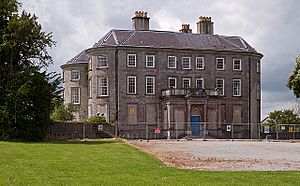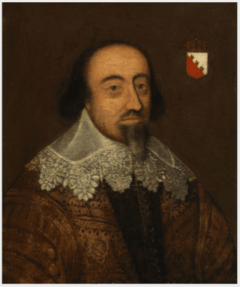William St Leger facts for kids
Quick facts for kids
Sir William St Leger
|
|
|---|---|

St. Leger family home at Doneraile Court, rebuilt 1690s
|
|
| Lord President of Munster | |
| In office 1627–1642 |
|
| Personal details | |
| Born | 12 August 1586 Ireland |
| Died | 9 July 1642 (aged 55–56) Doneraile Court, County Cork |
| Resting place | St Mary's, Doneraile |
| Spouses |
|
| Children | (1) Elizabeth (1618–1685); William (1620–1644) (2) John (1637–1692); Barbara |
| Parents |
|
| Military service | |
| Rank | Lieutenant-General |
| Battles/wars | |
Sir William St Leger (1586–1642) was an important figure in Irish history. He was an Anglo-Irish landowner, a government official, and a soldier. He started his military career fighting in the Eighty Years' War against Spain.
In 1624, he moved to Ireland. There, he became a Member of Parliament for County Cork. He also served as the Lord President of Munster, a high-ranking government position. During the Irish Rebellion of 1641, he played a key role in trying to stop the uprising in Munster. He died in 1642.
Contents
Sir William's Early Life and Family
William St Leger was born in August 1586, likely in County Cork, Ireland. He was the oldest son of Sir Warham St Leger and Elizabeth Rothe. His father held several important jobs in Munster. Sadly, his father was killed in 1600 during the Nine Years' War.
His Grandfather's Legacy
William's grandfather, Anthony St Leger, was also a very important person. He served as the Lord Deputy of Ireland from 1540 to 1548. This shows that William came from a family with a history of serving in government.
William's Marriages and Children
While living in Dordrecht during the Dutch War of Independence, William married Gertrude de Vries in 1616. They had two children together. Their son, William (1620-1644), died fighting for the King's side during the First English Civil War. Their daughter, Elizabeth (1618–1685), married Murrough O'Brien, 1st Earl of Inchiquin in 1635.
After Gertrude de Vries passed away, William married his second wife, Gertrude Heywood. They had two more children, John (1637–1692) and Barbara.
Sir William's Military and Political Career
Not much is known about St Leger's early career before 1607. In that year, he was involved in a duel where someone was killed. He sought safety with Hugh O'Neill, Earl of Tyrone, a leader of a rebellion.
Starting in the Netherlands
When O'Neill went into exile, St Leger went with him to Brussels. However, St Leger was a Protestant, so he did not join the Spanish army. Even though the Twelve Years' Truce had paused the Eighty Years War, he moved to the Dutch Republic and became a soldier.
In May 1610, King James I pardoned him for the duel. St Leger was then made a captain in an English army unit serving the Dutch. This unit fought in the War of the Jülich Succession. This war is sometimes seen as a start to the bigger Thirty Years War.
Gaining Influence and Land
Many English officers in the Dutch army found it helpful to have local connections to get promoted. This might have been a reason for St Leger's marriage to Gertrude de Vries in 1616. Soon after, he became connected to George Villiers, 1st Duke of Buckingham, who was very powerful because of his close relationship with King James I.
With Buckingham's help, St Leger was knighted in 1618. He also received land in Leinster, Ireland. This was part of a plan to transfer land from Irish Catholics to Protestant settlers. After the truce ended in 1622, St Leger helped defend Bergen op Zoom under Sir Charles Morgan. In 1624, he managed lands in Upper Ossory that King James I had given to Buckingham.
St Leger also helped organize a difficult attack on Saint-Martin-de-Ré in 1627. Buckingham was killed in August 1628, which was met with public happiness.
Leading in Ireland: 1627 to 1642
In March 1627, St Leger joined the Privy Council of Ireland. This was a group of advisors to the King in Ireland. He also took over from Buckingham's half-brother, Sir Edward Villiers, as the President of Munster.
Political Challenges in Munster
As President of Munster, St Leger faced a challenge from Richard Boyle, 1st Earl of Cork. Boyle was a powerful local rival. To balance this power, St Leger became an ally of Thomas Wentworth, Earl of Strafford. Wentworth became the Lord Deputy of Ireland in January 1632.
In 1630, St Leger suggested a new plan for settling land in County Tipperary. This plan was never put into action. However, it fit with Strafford's goal of increasing Protestant power in Ireland.
Serving in the Irish Parliament
Strafford was focused on increasing the King's money and stopping corruption. This affected new English settlers like Boyle. St Leger was elected as a Member of Parliament for County Cork in the Irish Parliament of 1634–1635. He supported Strafford's plan to make some agreements with Catholic nobles in exchange for money for the King.
The Bishops' Wars and Irish Army
The first of the Bishops' Wars in 1639 ended with Scottish Covenanters in control of Scotland. King Charles I wanted to reverse this. In December 1639, Strafford called the 2nd Irish Parliament of King Charles I to approve money for an Irish army. This army would go to Scotland.
St Leger was re-elected for County Cork to the Irish Parliament of 1640–1649. The Parliament voted to give money to create an Irish army of 9,000 soldiers. This army was meant to fight the Scots in the Second Bishops' War.
St Leger was put in charge of training these new soldiers. They were based in Carrickfergus. In July 1640, St Leger said they were ready to fight. However, they stayed in Ireland during the Second Bishops' War. This situation made the disagreements between Strafford and his opponents in both the Irish and English Parliaments even worse. This led to Strafford's trial and execution in May 1641.
The Irish Rebellion of 1641
A new problem arose: what to do with the newly formed army. Many of the soldiers were Catholic, and the Protestant government in Dublin Castle administration did not trust them. It was decided they could serve Spain. When the Irish Rebellion began in October 1641, about 2,500 men were waiting in Kinsale to sail to the Spanish army.
As Lord President, St Leger was responsible for dealing with the rebels in Munster. However, he did not have enough soldiers or supplies. In February 1642, he received help when Charles Vavasour and his soldiers arrived at Youghal. Vavasour also brought the King's declaration against the rebels. St Leger was still fighting the rebellion when he died on July 2, 1642. He died either at Doneraile Court or in Cork.
Images for kids



